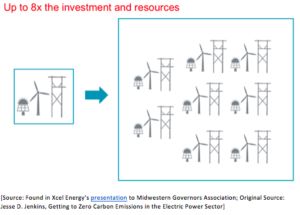In what can only be described as revealing (and unsurprising), a 2019 March presentation by Xcel Energy supports our concerns about the cost of transitioning to 100 percent renewable energy.
To prevent ratepayers from curtailing their daily electric usage, Xcel believes it will need eight to sixteen weeks of storage capacity. Keep in mind, this projection is based on its current footprint of 3.6 million electric customers living in service areas throughout eight states. Nevertheless, if Xcel Energy is to build enough storage to cover peak demand (2020 projections from Northern States Power, Public Service Company, and Southwestern Public Service) and last at least eight weeks (which is the low-end estimate) it will need to have close to 27 million megawatt hours of battery storage installed and online to prevent curtailment and maintain the status quo.
Furthermore, in Xcel’s words not mine, this transition may also demand a massive overbuild of up to 8x what’s actually required to provide reliable electricity with the utility’s current transmission and distribution network and mix of renewable, hydrocarbon, and nuclear-powered generation.

Not considering the cost of the massive overbuild of generation Xcel expects it will need, the storage alone could cost up to $20 trillion. This is an unfathomable price tag, and it will fluctuate depending on the type of generation/storage built, weather patterns of the specific geographic location, and whether or not Xcel will build enough storage to cover its peak load. The $20 trillion figure is based off cost projections from a recently released report from the Independence Institute (with a 50 percent drop in battery prices assumed), Xcel’s 2020 peak demand for all of its service territories, and an eight-week duration requirement.
In sum, for $20 trillion, or about $6 million per electric customer, people will maintain their current quality of life and not worry about cutting back on their electricity usage.
Seconding what we said in our report, the Xcel presentation included a slide explaining that the price tag of transitioning to 100 percent renewables behooves stakeholders, elected officials, and the laity to consider other options that would reduce the power sector’s CO2 emissions.
Although not explicitly stated by Xcel, implicitly, the utility is recommending nuclear generation, the source that’s zero-carbon and operates 24 hours a day, 7 days a week. The perks of going nuclear would be a reduction in CO2, steady tax revenue, long-term employment, and most importantly, reliable generation. Yes, nuclear is expensive up front, but once built, it has the cheapest levelized cost of energy among existing sources.
Vindication isn’t a victory – especially for the electric ratepayers who will be on the hook for rising rates. Nevertheless, it is nice to see Xcel being intellectually honest about transitioning to 100 percent renewables, as paying for all that heavy lifting will fall on its customers.
Brit Naas is an energy policy anlalyst at the Independence Institute’s Energy and Environmental Policy Center.


